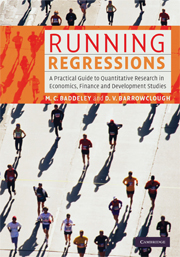 Running Regressions
Running Regressions Book contents
- Frontmatter
- Contents
- List of figures
- List of tables
- List of boxes
- Acknowledgements
- List of acronyms
- How to use this book
- Part I Simple regression and data analysis
- 1 An introduction to Ordinary Least Squares
- 2 Running simple regressions
- 3 Using logs and estimating elasticities
- 4 Hypothesis testing
- Part II Multiple regression and diagnostic testing
- Part III Time-series econometrics
- Part IV Advanced topics
- Index
- References
2 - Running simple regressions
Global poverty and economic growth
Published online by Cambridge University Press: 05 June 2014
- Frontmatter
- Contents
- List of figures
- List of tables
- List of boxes
- Acknowledgements
- List of acronyms
- How to use this book
- Part I Simple regression and data analysis
- 1 An introduction to Ordinary Least Squares
- 2 Running simple regressions
- 3 Using logs and estimating elasticities
- 4 Hypothesis testing
- Part II Multiple regression and diagnostic testing
- Part III Time-series econometrics
- Part IV Advanced topics
- Index
- References
Summary
The test of our progress is not whether we add to the abundance of those who have much; it is whether we provide enough for those who have too little.
US President Franklin D. Roosevelt, 2nd inaugural address, 1937.Economic issues include:
Poverty reduction – the role of investment and trade
Millennium Development Goals (MDGs)
Development economics and development institutions
Econometric issues include:
Correlation coefficients
Running OLS regressions ‘by hand’
Single hypothesis tests: Student's t test
Point estimates and confidence intervals
Goodness of fit and the coefficient of determination
Data issues include:
Quantitative indicators of development
A qualitative indicator – the Human Poverty Index
The issue
How can we reduce poverty and improve living standards for the poor? There are no easy answers and in addressing the problems of global poverty, the world's heads of state met in September 2000 to discuss a universal framework for development, agreeing on targets to promote development. The then 189 UN member states agreed to the eight Millennium Development Goals (MDGs) listed in Box 2.1. Poverty reduction was one of these primary goals and the UN member states pledged to halve world poverty by 2015. These goals were reaffirmed at the World Summit held in September 2005, and the issue has been kept alive ever since by a number of high-profile awareness-raising and fund-raising events, backed by a diverse range of people – rockstars included.
Box 2.1 The Millennium Development Goals (MDGs)
• Eradicate extreme poverty and hunger
• Achieve universal primary education
• Promote gender equality and empower women
• Reduce child mortality
• Improve maternal health
• Combat HIV/AIDS, malaria and other diseases
• Ensure environmental sustainability
• Develop a global partnership for development
Source: www.un.org/millenniumgoals/Information
- Type
- Chapter
- Information
- Running RegressionsA Practical Guide to Quantitative Research in Economics, Finance and Development Studies, pp. 36 - 63Publisher: Cambridge University PressPrint publication year: 2009